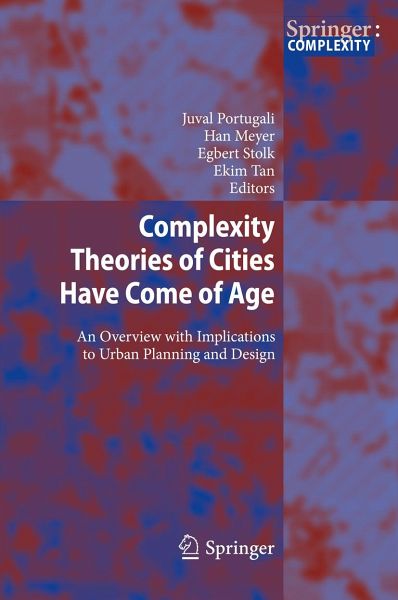
Complexity Theories of Cities Have Come of Age (eBook, PDF)
An Overview with Implications to Urban Planning and Design
Redaktion: Portugali, Juval; Tan, Ekim; Stolk, Egbert; Meyer, Han
Versandkostenfrei!
Sofort per Download lieferbar
72,95 €
inkl. MwSt.
Weitere Ausgaben:

PAYBACK Punkte
36 °P sammeln!
Today, our cities are an embodiment of the complex, historical evolution of knowledge, desires and technology. Our planned and designed activities co-evolve with our aspirations, mediated by the existing technologies and social structures. The city represents the accretion and accumulation of successive layers of collective activity, structuring and being structured by other, increasingly distant cities, reaching now right around the globe.This historical and structural development cannot therefore be understood or captured by any set of fixed quantitative relations. Structural changes imply t...
Today, our cities are an embodiment of the complex, historical evolution of knowledge, desires and technology. Our planned and designed activities co-evolve with our aspirations, mediated by the existing technologies and social structures. The city represents the accretion and accumulation of successive layers of collective activity, structuring and being structured by other, increasingly distant cities, reaching now right around the globe.
This historical and structural development cannot therefore be understood or captured by any set of fixed quantitative relations. Structural changes imply that the patterns of growth, and their underlying reasons change over time, and therefore that any attempt to control the morphology of cities and their patterns of flow by means of planning and design, must be dynamical, based on the mechanisms that drive the changes occurring at a given moment.
This carefully edited post-proceedings volume gathers a snapshot view by leading researchers in field, of current complexity theories of cities. In it, the achievements, criticisms and potentials yet to be realized are reviewed and the implications to planning and urban design are assessed.
This historical and structural development cannot therefore be understood or captured by any set of fixed quantitative relations. Structural changes imply that the patterns of growth, and their underlying reasons change over time, and therefore that any attempt to control the morphology of cities and their patterns of flow by means of planning and design, must be dynamical, based on the mechanisms that drive the changes occurring at a given moment.
This carefully edited post-proceedings volume gathers a snapshot view by leading researchers in field, of current complexity theories of cities. In it, the achievements, criticisms and potentials yet to be realized are reviewed and the implications to planning and urban design are assessed.
Dieser Download kann aus rechtlichen Gründen nur mit Rechnungsadresse in A, B, BG, CY, CZ, D, DK, EW, E, FIN, F, GR, HR, H, IRL, I, LT, L, LR, M, NL, PL, P, R, S, SLO, SK ausgeliefert werden.












